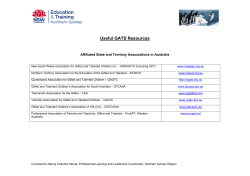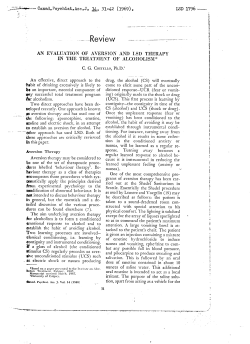
P82 SENSORY FOOD AVERSION AND GIFTED CHILDREN
P82 PAGE 1 SENSORY FOOD AVERSION AND GIFTED CHILDREN FACTSHEET Summary NAGC has produced this Fact Sheet as an introductory guide to the topic of Sensory Food Aversion. Sensory Food Aversion is a condition whereby certain food appearances, textures or odours cause a child to refuse to eat that particular food. Extreme Sensory Food Aversion that causes anxiety, upset, nauseous feelings or even vomiting is a serious condition which can seriously affect a person‟s life-long relationship with food. This Fact Sheet offers guidance on how to increase the variety and volume of food consumption for your child, and offers useful strategies to help reduce anxiety, aversion and negative behaviours associated with food and meal times. Introduction Children with Sensory Food Aversion will refuse to eat certain foods because of taste, texture, smell or appearance. Eating a healthy, balanced diet is not only a natural part of life, but also a vital part of life. As children are reliant on their parents to meet their nutritional needs, it is of course incredibly frustrating and upsetting when your child refuses to eat the food that you have prepared for them. Parents can feel guilty about being unable to ensure that their child is receiving the correct nutrition that will optimise both physical and mental development. Parents of gifted children may worry that an eating problem will further affect their child‟s asynchronous development (please see NAGC Fact Sheet on Asynchronous Development for further advice on this topic) and that this will somehow exacerbate physical and/or emotional developmental delay. Indications of Sensory Food Aversion The way a child reacts to certain foods will indicate whether or not they have a Sensory Food Aversion. If your child displays the following negative behaviours regularly, it is likely that they have a Sensory Food Aversion: Grimacing Gagging Spitting Vomiting Refusal to eat a particular food Generalising food types- food groups, even food brands Eating only limited foods Become upset if the „offending‟ food touches other foods on plate Gifted Characteristics and Sensory Food Aversion Many gifted children suffer from anxiety, perfectionism, self-esteem issues which can often stem from a feeling of isolation and being misunderstood. It is also very common for gifted children to be highly sensitive to textures, sights, tastes, smells, noise and light. These traits can have a definite impact on the child‟s relationship with food from a very early age. Fully understanding your child – their quirks, sensory issues, their worries, and fears; will enable you to begin to understand why they are holding on to negative behaviour patterns associated with food. This is often a defense mechanism rooted in the fear of something distasteful and/or unpleasant. Building up trust by engaging in enjoyable, challenging and regular activities with your child is an essential first step in dealing with eating problems. An active, lively, happy child that trusts and enjoys the company of their parents is already more receptive to subtle changes during meal times which you may need to incorporate on a gradual basis. © National Association for Gifted Children 2010 - 2012 www.nagcbritain.org.uk Information and Advice Service Charity No: 313182 0845 450 0295 P82 PAGE 2 SENSORY FOOD AVERSION AND GIFTED CHILDREN FACTSHEET Extreme Sensitivity – Super Tasters and Super Noses! In many families of gifted children, there are incidences when a gifted child is able to sniff out certain smells instantly compared with others in the family who may not notice them at all. For example, a gifted child may notice that an aunt or uncle smells „smoky‟. Or they may detect the slightest whiff of chocolate after a family member has eaten, despite not seeing any in the room. This highly sensitive sense of smell adds to this type of child also being a Super Taster. It can be difficult for people who are not highly sensitive to understand just how heightened senses can be; research shows that it is very common for gifted children to be highly sensitive to tastes and smells. This can mean that to them, the feeling, taste and smell of certain foods are overwhelming and very difficult to cope with. Their highly sensitive senses of smell and touch find it difficult to taste, chew and eventually swallow certain foods which may be unpleasant in texture, smell or taste. Please see the NAGC Factsheet on Hypersensitivity (Dabrowski‟s Overexcitibilities) for further information on sensory hypersensitivity. Implications of Sensory Food Aversion Sensory Food Aversion in gifted children can have far-reaching consequences and effects on general well-being as it can severely affect interpersonal relationships, behaviour, development, self-esteem, socialisation and cognitive ability. Food aversions must therefore be taken very seriously and not left unchecked or treated long-term. Health professionals would advise skilled intervention as soon as the food aversion is becoming entrenched in your child‟s daily life and is affecting their behaviour and development negatively. A child suffering from severe Sensory Food Aversion may refuse to eat foods from an entire food group essential for a healthy diet of a growing child. Children refusing to eat vegetables, dairy or meats will lack the vital minerals, vitamins and proteins they need to develop good health. There are also implications for oral motor development if children refuse to eat foods that require significant chewing. This can eventually lead to problems with articulation and speech development. Sensory food aversion, food refusal and food selectivity in extreme forms require professional treatment as these issues also have a negative impact on the child‟s behaviour and this can cause a lot of stress within the family. The child‟s problem with eating can become all-encompassing; therefore, successful treatment programmes will include strategies for the whole family to incorporate. There are also social implications of Sensory Food Aversion; children may feel very uncomfortable during lunchtimes at school, birthday parties, play dates, visits to family, etc, as they will not want others to notice their issues with eating and food. All of the above implications make it starkly evident that this can be a serious condition that requires immediate attention and intervention by parents and/or health professionals. Control Issues Control remains a key component of many eating disorders; and it is this control that these children are reluctant to relinquish to their parents or to professionals involved in treatment. Gifted children in particular, can be highly willful. When challenged to change negative behaviours, they are likely to become even more resistant. In treating gifted children that have problems with eating, it is advisable to follow a holistic approach and understand that this type of child has complex cognitive, social, emotional and disciplinary needs. © National Association for Gifted Children 2010 - 2012 www.nagcbritain.org.uk Information and Advice Service Charity No: 313182 0845 450 0295 P82 PAGE 3 SENSORY FOOD AVERSION AND GIFTED CHILDREN FACTSHEET Classification of Food Aversions Food aversions have been classified into four types of foods that are rejected because they are: 1. Dangerous- for example a gifted 2 year old refusing to eat avocado states “that‟s poisonous”, because to him, the strange look of this unusual fruit with its blackish green bumpy outer skin and mushy pea green flesh, makes it appear to be dangerous and highly unappealing! 2. Inappropriate- for example a child who feels that anything other than sandwiches for lunch is „inappropriate‟ or only for adults or that „exotic‟, or „different‟ foods are inappropriate because they do not fit in with their idea of what food should smell/look/taste/feel like. 3. Disgusting- could be the look of the food, smell, texture, past experience involving the food or a fact about the food (for example an aversion to milk because it comes from the udders of a cow and would therefore be smelly/dirty. 4. Distasteful- examples of which are any foods that can be eaten, but only if they are hidden or blended to mask the texture or sight of them- for example carrots blended into pasta sauce. Helpful strategies to reduce Sensory Food Aversion: Allow your child to handle foods with different textures as much as possible. Even if they don‟t eat the prepared meal, allow them to help during preparation- from taking potatoes out of a bag, to washing peppers under the tap, to pouring pasta into a pot, whisking an egg, kneading dough, etc. Do try to sit down as a family and eat meals together as often as possible. Meal times will then become something to look forward to and provide enjoyable opportunities to catch up as a family. Make meal times fun, not stressful. Lead by example and do not graze all day- rather savour and enjoy a prepared family meal. Do not overwhelm your child with too much food during meal times- one heaped tablespoon per age of child is advisable to begin with. Do not offer more than 3 different food types during a meal. Never, ever force feed your child. If your child gags after eating certain foods, offer that type of food after a few weeks interval. Distraction during meal times can be a useful tool to alleviate anxiety. This can include conversations about positive/exciting things that are happening at present or in the future, funny stories, playing relaxing or even upbeat music- the list is endless. Food Chaining technique- gradually build up „acceptable‟ foods. For example, if your child will eat a plain biscuit, gradually introduce crackers, then cracker bread, dry toast, toast with margarine, toast with a thin layer of cream cheese, toast with wafer thin ham, a sandwich with a filling of their choice, etc. Similarly with other foods and drinks follow a set pattern of food chaining to eventually build up a nutritionally diverse and acceptable diet that is essential for a growing child. Food chaining must always follow the same shape, colour and texture for success. This conveys the idea that new food is safe food as it is familiar and therefore acceptable. Although tempting, do not beg, cajole, plead, or bribe children to eat. This will ultimately backfire and can become a weapon that a child will use to further control meal times. Do not given them the same foods on a daily basis. Explain that this is not only boring as there are so many different foods to choose from, but also eating the same food all the time does not provide the body with a varied diet that is essential to all round growth and wellbeing. © National Association for Gifted Children 2010 - 2012 www.nagcbritain.org.uk Information and Advice Service Charity No: 313182 0845 450 0295 P82 PAGE 4 SENSORY FOOD AVERSION AND GIFTED CHILDREN FACTSHEET Further Information Books can be ordered from our website shop: www.nagcbritain.org.uk/shop.php P74 Hypersensitivity (Dabrowski‟s Overexitibilities) www.nagcbritain.org.uk/parents.php?id=92 P56 Asynchronous Development www.davidsongifted.org/db/Articles_id_10204.aspx NAGC Fact Sheet with further information on the hypersensitive nature of gifted children. NAGC Fact Sheet on the asynchronous development of gifted children Tips for parents on dealing with Food Selectivity Meals Without Tears: How to get Your Child to Eat Healthily and Happily, a book by Dr. Rana Conway Help for parents at „their wit‟s end‟ with their child‟s eating problems Just Two More Bites! Helping Picky Eaters Say Yes to Food, a book by Linda Piette Offers „concrete help for frustrated parents‟ © National Association for Gifted Children 2010 - 2012 www.nagcbritain.org.uk Information and Advice Service Charity No: 313182 0845 450 0295
© Copyright 2025





















